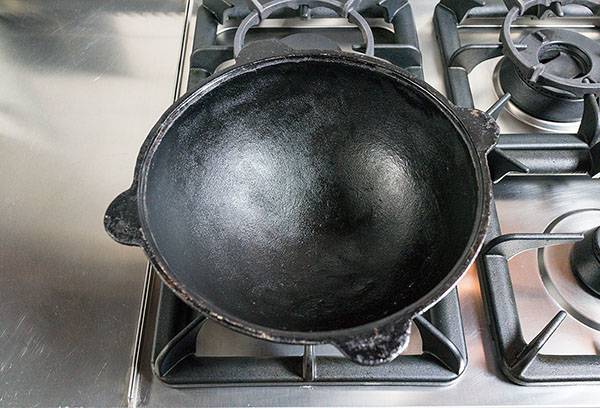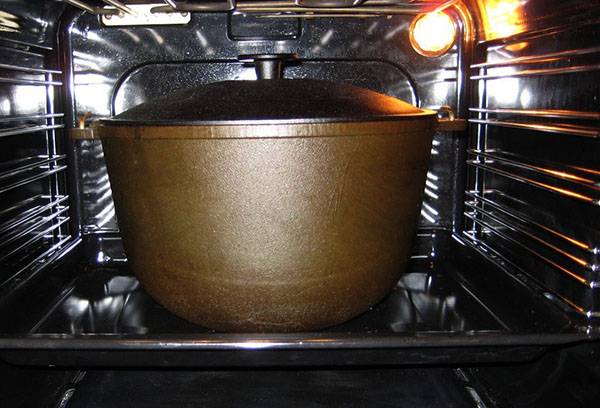How to clean an old cauldron at home from carbon deposits and rust?
With prolonged use, cast iron cookware becomes covered with soot, and if the rules of storage and operation are not followed, it becomes covered with rust. When this happens, the housewife has a logical question: how to clean the cauldron from carbon deposits and remove rust? There are many ways to do this, let’s focus on a few of the simplest and most effective.

Methods for cleaning a cauldron from carbon deposits
Faithful helpers in the fight against carbon deposits are laundry soap and PVA glue.
- Find a large container for boiling water, into which the cauldron will fit completely if there is carbon deposits on the outer walls. If you have it exclusively inside, you can immediately proceed to the second stage.
- Coarsely rub a piece of laundry soap.
- Pour water into the vat, pour soap shavings into it, squeeze out glue (50-65 g bottle). If you clean the cauldron only inside, pour water into it, and reduce the amount of soap and PVA by three.
- Put it on fire. When it boils, reduce to low. Simmer the cauldron for three hours, adding water if necessary.
- Take it out, pour out the water and clean it with the hard side of the sponge - the softened carbon deposits will easily come off.
The second method is based on the use of acid rather than alkali. It requires products that every housewife has: table vinegar, table rock salt and baking soda.
- Pour 2-4 tablespoons of salt into the cauldron (depending on the volume), pour 100-200 ml of vinegar into it and put on fire.
Advice: Don't forget to open the windows and leave the room so as not to breathe in harmful fumes.
- When the vinegar boils, pour 60-100 g of soda into it, reduce the heat and leave on it until all the vinegar has evaporated. This will happen quite quickly, but there is no danger in missing it: nothing bad will happen to the cauldron, even if it sits on low heat for a couple of minutes.
- Rinse the cauldron under running water. If the carbon deposits do not come off everywhere, scrub with a brush and rinse again.
There is another “old-fashioned” way to remove carbon deposits at home: the cauldron is completely filled with sand and placed on low heat overnight. By morning all that remains is to pour out the sand and rinse the dishes.
Methods for removing rust from cast iron cookware
Rust can be a little more difficult to remove, especially if the stains are old, but there are several answers on the Internet to the question of how to clean rust from a cauldron, and they work.
For the first method, you will need the same vinegar and salt; you don’t need soda, but you do need vegetable oil.
- Dilute table vinegar with water. The amount depends on the volume of the cauldron: you need the solution to be above the level of rust stains. If they are also available outside, then much more water and vinegar will be needed - the cauldron will have to be immersed in a large vat. The ratio of water and vinegar is one to one.
- After a few hours (at least two), the vinegar solution is drained. A tablespoon of salt is poured into 20 ml of vegetable oil. Use this paste to rub the rust with a hard sponge until it comes off.
Advice When working, use household gloves to avoid “erasing” your nails.
- Grease the cauldron with oil and place in the oven for an hour. Heat the cauldron with oil to create a protective layer on it and prevent further oxidation of iron.
- Remove and carefully wipe with a napkin. After this, do not use laundry soap or metal brushes for washing, so as not to remove the protective layer.
The second method is grinding. You can sand the cauldron using Pemolux and the hard side of the sponge, sandpaper.
Advice
You can polish the cauldron without making any effort using an electric drill using a special attachment.
The third method is called digestion, it is the most economical and safe, but takes a lot of time (10 hours). A concentrated saline solution is created (a glass of salt per liter of water) and poured into a cauldron, after which it is placed on the lowest possible heat. Boil the saline solution all day, constantly making sure that there is enough liquid in the container. If you start in the morning, then by evening you will be able to enjoy the cleanliness of the updated cauldron.
The fourth method also does not require too much effort, since it involves the use of potent products containing oxalic or phosphoric acid. We are talking about purchased products created specifically for removing rust stains.
Advice
By boiling Coca-Cola in a cauldron, you can easily clean off rust, since this drink contains phosphoric acid.
If there are minor signs of rust, the cauldron can be cleaned using raw potatoes, cutting them in half and treating the cut area with rust.
Protecting cast iron cookware from rust stains
In order not to rack your brains over how to clean a cauldron from rye and carbon stains, you need to store and use it correctly. In particular, cast iron cookware should not be stored in places with high humidity. After use and washing, it should be dried in the oven or at least wiped well.
A cast iron cauldron lasts longer if it is calcined regularly. This is very easy to do with salt: pour it inside, place the cauldron on the stove and heat over low heat until the salt darkens. Afterwards all that remains is to pour out the salt and wait for the cauldron to cool down.
To prevent the formation of rust, you need to ensure that there is always a protective layer on the cauldron. How to create it using oil is described above (lubricate and bake in the oven).
If you wash the cauldron immediately after use, then the maximum that is required to remove carbon deposits is to soak the dishes in water for a short time and rub with the hard side of the sponge.
Cleaning a cauldron at home is not difficult, but keeping it clean is even easier.


I boiled cola in a cauldron and there really was no more rust. Great way